10 Best Tools for Monitoring Offshore Teams

Top Tools for Monitoring Offshore Teams:
- Hubstaff: Tracks productivity with screenshots and activity monitoring.
- Time Doctor: Offers detailed analytics, real-time tracking, and inactivity detection.
- Trello: Simple task management with Kanban boards and integrations.
- Asana: Advanced project management with timeline views and workload tracking.
- Toggl: Time tracking with budget alerts and multi-currency support.
- Clockify: Real-time tracking and detailed reporting for better oversight.
- Microsoft Teams: Communication and collaboration with activity dashboards.
- Slack: Channel-based messaging for seamless team communication.
- Jira: Project tracking with customizable workflows and sprint reports.
- RescueTime: Tracks productivity trends without intrusive monitoring.
Quick Comparison Table:
| Tool | Key Features | Pricing (Starting) |
|---|---|---|
| Hubstaff | Screenshots, activity tracking | $7/user/month |
| Time Doctor | Real-time tracking, GDPR-compliant | $7/user/month |
| Trello | Kanban boards, task updates | Free/$5 user/month |
| Asana | Timeline, workload management | Free/$10.99 user/mo |
| Toggl | Time tracking, budget alerts | $9/user/month |
| Clockify | Real-time tracking, reports | Free/$3.99 user/mo |
| Microsoft Teams | Collaboration, analytics | Included in MS 365 |
| Slack | Messaging, integrations | Free/$7.25 user/mo |
| Jira | Agile tools, customizable workflows | $7.75 user/month |
| RescueTime | Productivity pulse, privacy-focused | $72/user/year |
Key Takeaways:
- Time tracking tools like Hubstaff, Time Doctor, and Toggl help monitor productivity and manage hours across time zones.
- Project management tools like Trello, Asana, and Jira ensure smooth task delegation and progress tracking.
- Communication tools like Microsoft Teams and Slack keep offshore teams connected.
- Privacy-first options like RescueTime focus on insights without invasive tracking.
Choose a tool based on your team's size, roles, and budget to streamline operations and boost productivity.
The Best Employee Monitoring Software
1. Hubstaff
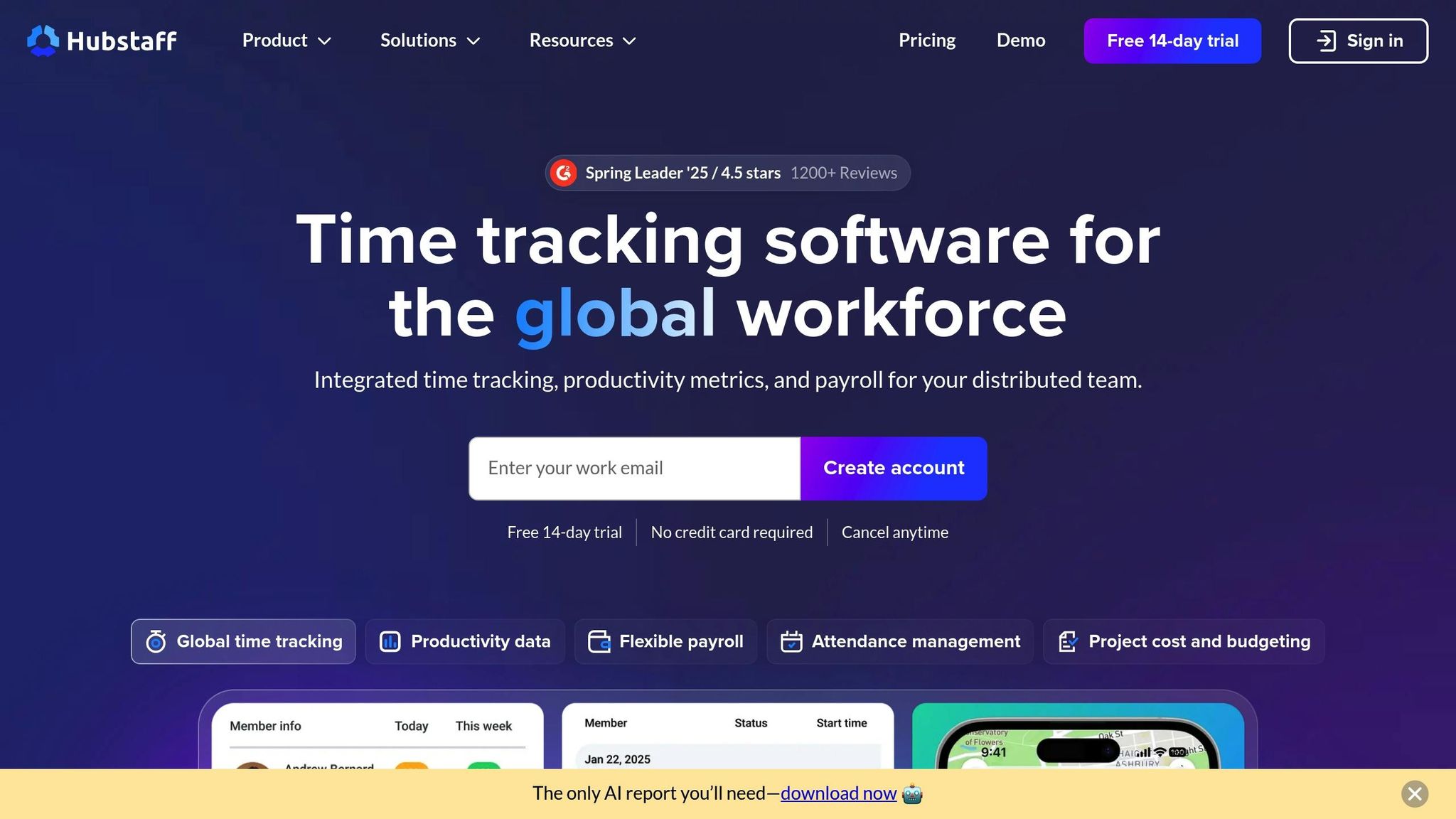
Hubstaff is a tool designed to monitor and track productivity, particularly for offshore teams. It takes periodic screenshots and keeps an eye on keystrokes and mouse movements to help assess team focus and engagement.
With its real-time tracking capabilities, Hubstaff enhances oversight and helps improve efficiency. Here are some features that are especially useful for managing offshore teams:
| Feature | How It Helps Offshore Teams |
|---|---|
| Screenshot Capture | Offers a visual log of tasks being worked on |
| Activity Monitoring | Tracks keystrokes and mouse activity to measure engagement |
2. Time Doctor

Time Doctor builds on features like visual and activity tracking by providing deeper analytics for managing offshore teams. It strikes a balance between ensuring productivity and respecting team privacy.
Here’s what it offers for tracking work hours:
| Feature | Benefit for Offshore Management |
|---|---|
| Real-time Activity Tracking | Tracks work time with automated screenshots |
| Inactivity Detection | Pauses tracking after 10 minutes of idle time |
| Multi-timezone Support | Adjusts timestamps to match the manager's local time zone |
| Offline Mode | Keeps tracking even during internet outages |
Pricing starts at $7 per user/month, with advanced plans available at $20 per user/month. These higher-tier plans include VIP support and custom API access.
A case study highlighted a 15% boost in project profitability by optimizing time management [3]. Additional features like the Work/Life Balance Report help spot burnout risks, while the Client Billing Report simplifies invoicing with automatic currency conversion.
Time Doctor is GDPR-compliant, offering blurred screenshots, customizable data retention policies, regional data storage, and selective monitoring. Its Trello integration lets users log time directly within task cards, making it easier to manage projects across different time zones.
The Focus Time feature blocks distracting websites during periods of deep work, and a low-bandwidth mode reduces data usage by 40% - a huge plus for teams in areas with limited internet access.
According to user data, 73% report less time theft, and the tool holds a 4.5/5 rating on Capterra from over 1,200 reviews [2]. Productivity reports and automated payroll functions are consistently praised by users.
Time Doctor’s approach to trust-building includes gentle inactivity alerts and site restrictions. This method is favored by 78% of offshore employees [4].
3. Trello
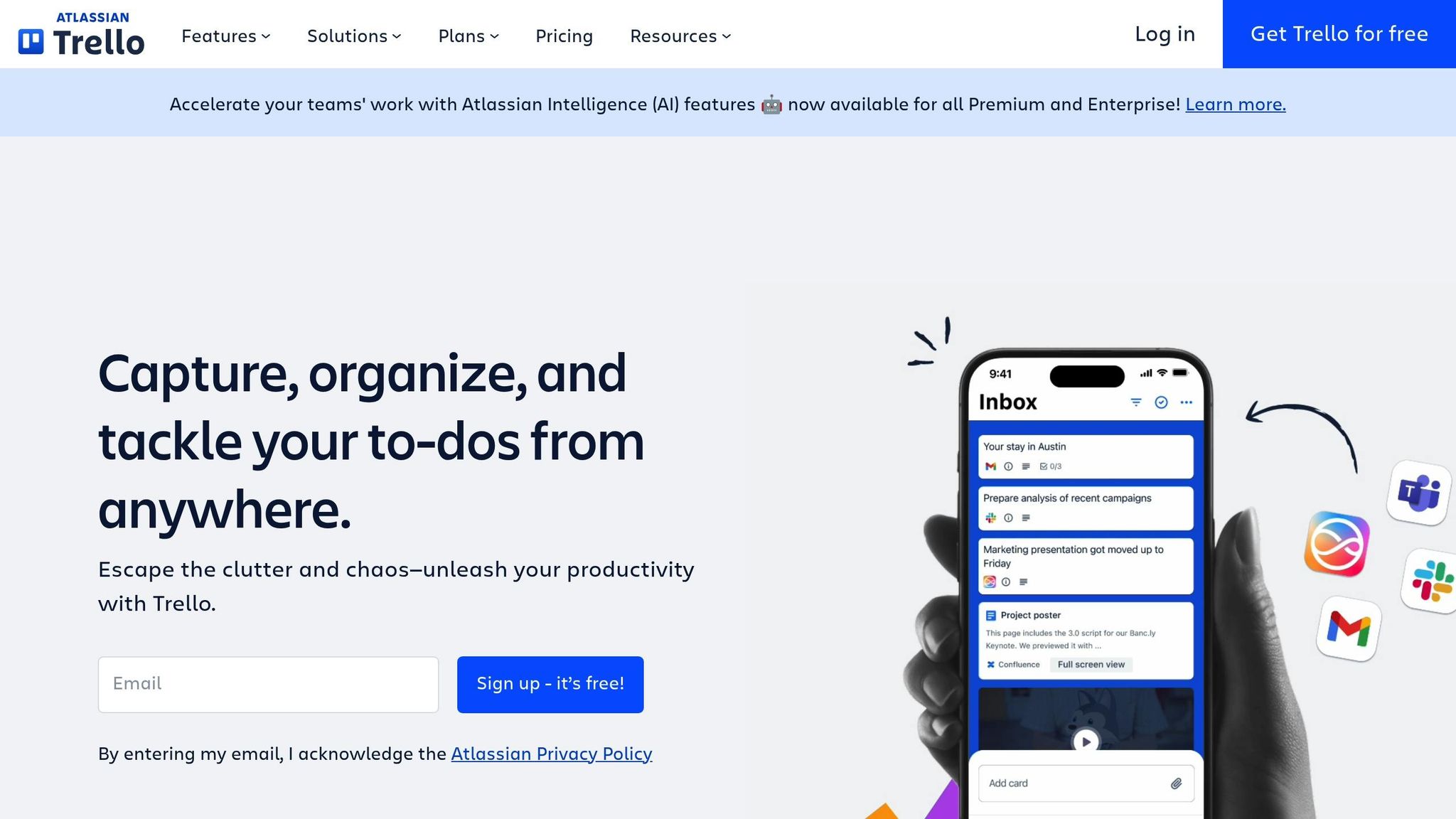
Trello's Kanban boards provide a straightforward way to visualize tasks, making it easier for managers to oversee and coordinate offshore teams. Its user-friendly interface and flexible workflows ensure smooth collaboration.
| Feature | How It Helps Offshore Teams |
|---|---|
| Board Activity Log | Tracks changes and updates in real time |
| Power-Up Integrations | Connects Trello with other productivity tools |
| Custom Fields | Adds essential tracking metrics directly to task cards |
| Butler Automation | Handles repetitive tasks, simplifying project updates |
Trello also offers additional Power-Ups to improve team management. For instance, the Card Aging Power-Up highlights tasks that haven't been updated, while the Calendar view helps track deadlines and milestones effectively.
The mobile app keeps teams informed and connected, even when they're on the move. Managers can easily monitor progress and ensure tasks stay on track.
To protect sensitive project details, Trello includes customizable permissions and data encryption.
4. Asana

Asana stands out as a project management tool designed to help offshore teams manage tasks and workflows efficiently.
| Feature | Monitoring Advantage |
|---|---|
| Timeline View | Displays project schedules and task dependencies |
| Workload Management | Keeps track of team capacity and resource usage |
| Custom Fields | Tracks specific metrics and key performance indicators (KPIs) |
| Progress Tracking | Delivers real-time updates and milestone tracking |
Its various views make it easy to switch between detailed task management and an overview of project progress. The Portfolio view is especially helpful for managers overseeing multiple projects, offering a clear snapshot of activities across offshore teams - ideal for coordinating efforts across time zones.
The Forms feature simplifies task creation by standardizing project requests. This ensures offshore team members provide consistent information, making it easier to monitor performance effectively.
With Automation Rules, Asana reduces manual effort by automating tasks like:
- Assigning tasks based on set conditions
- Updating statuses when criteria are met
- Sending alerts for overdue tasks
- Highlighting potential bottlenecks
For better visibility, the Dashboard lets managers build custom views to track metrics such as task completion, project progress, team workload, and deadlines.
Lastly, the Goals feature connects individual tasks to larger company objectives, helping offshore teams stay aligned with organizational priorities and ensuring accountability.
5. Toggl
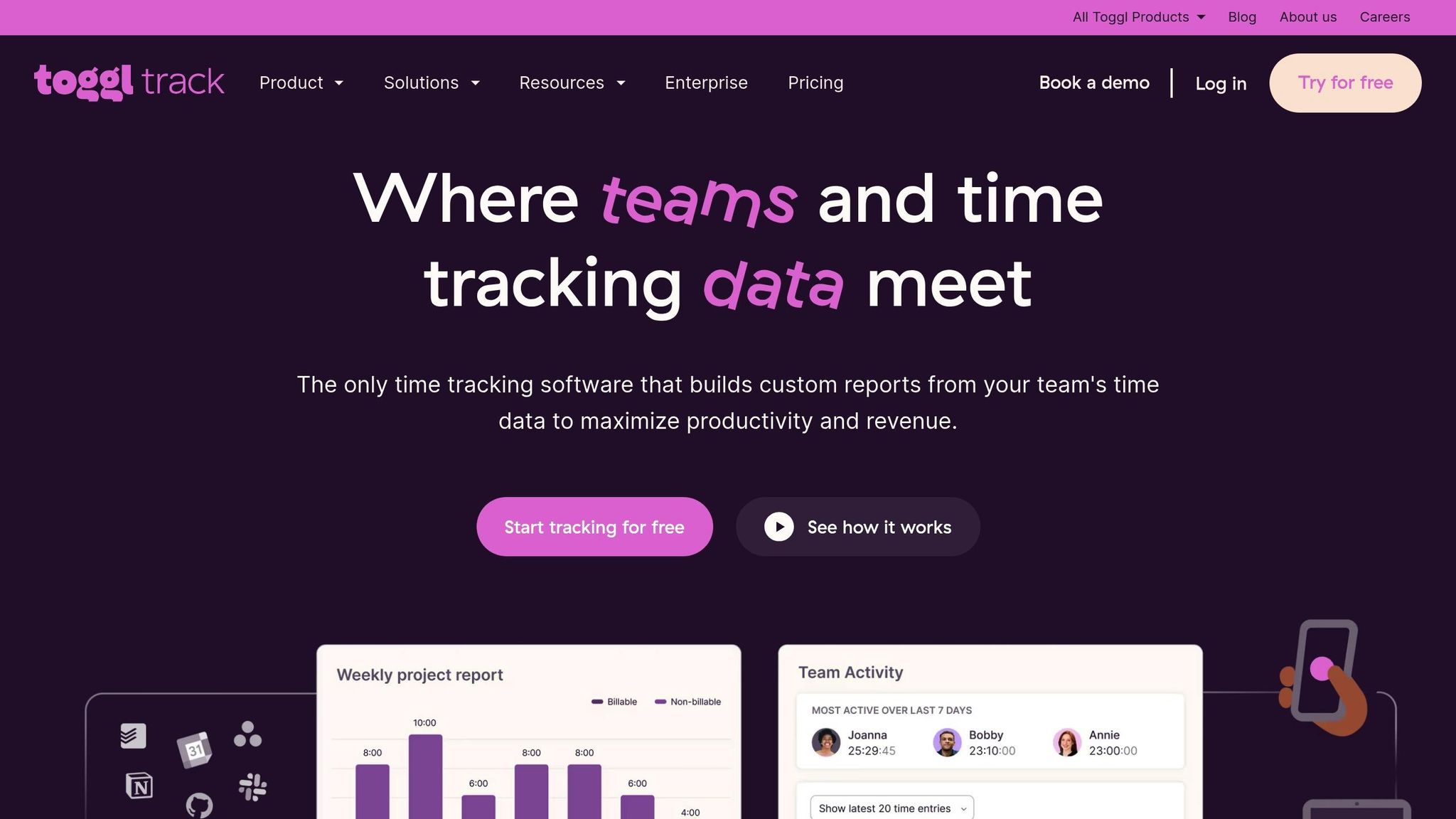
Toggl is a time-tracking tool designed to help global teams manage their work efficiently. It offers features that make tracking offshore productivity straightforward, along with detailed reporting to keep everything on track.
| Core Functionality | Benefits for Offshore Management |
|---|---|
| One-Click Tracking | Quickly track time with idle detection included |
| Project Dashboard | Get real-time data on team capacity |
| Time Zone Management | Automatically converts time zones for easier collaboration |
| Budget Alerts | Sends notifications at 50%, 75%, and 90% of budget usage |
| Multi-Currency Support | Handles over 20 currencies |
One standout feature is the "Team Timeline", which visually maps overlapping work hours. For example, a New York-Manila team reduced scheduling errors by 40% in Q3 2024 [7].
Toggl also helps businesses save money. A Texas-based SaaS company reported saving $12,000 per quarter by using budget alerts to flag spending issues early [6]. Similarly, Perception Engineering cut daily tracking time from two hours to just 15 minutes, while real-time budget alerts helped them avoid project overspending [8].
Security is a priority for Toggl. It uses SOC 2-compliant AWS servers, two-factor authentication, GDPR-compliant data processing, IP restrictions, and detailed audit logs to meet enterprise-grade security standards.
For teams spread across multiple countries, Toggl supports localization in 20 languages, including Spanish and Tagalog. In a test, 92% of non-technical users in Latin America learned its core features in under 15 minutes [4].
Toggl's reporting tools are another highlight. A California-based e-commerce company increased its offshore developer productivity by 20% after using Toggl’s "Project Efficiency" reports to pinpoint workflow issues [5].
Pricing starts at $9 per user per month (billed annually), with discounts for teams of 50 or more [4]. These features make it a cost-effective choice for managing offshore operations while boosting team productivity.
Toggl integrates seamlessly with tools like Asana, Jira, and GitHub, and connects to over 100 additional apps via Zapier. According to the 2024 Remote Tools Report, 68% of users pair Toggl with Slack for instant productivity updates [9].
Up next, we’ll dive into other tools that can further streamline offshore performance tracking.
6. Clockify
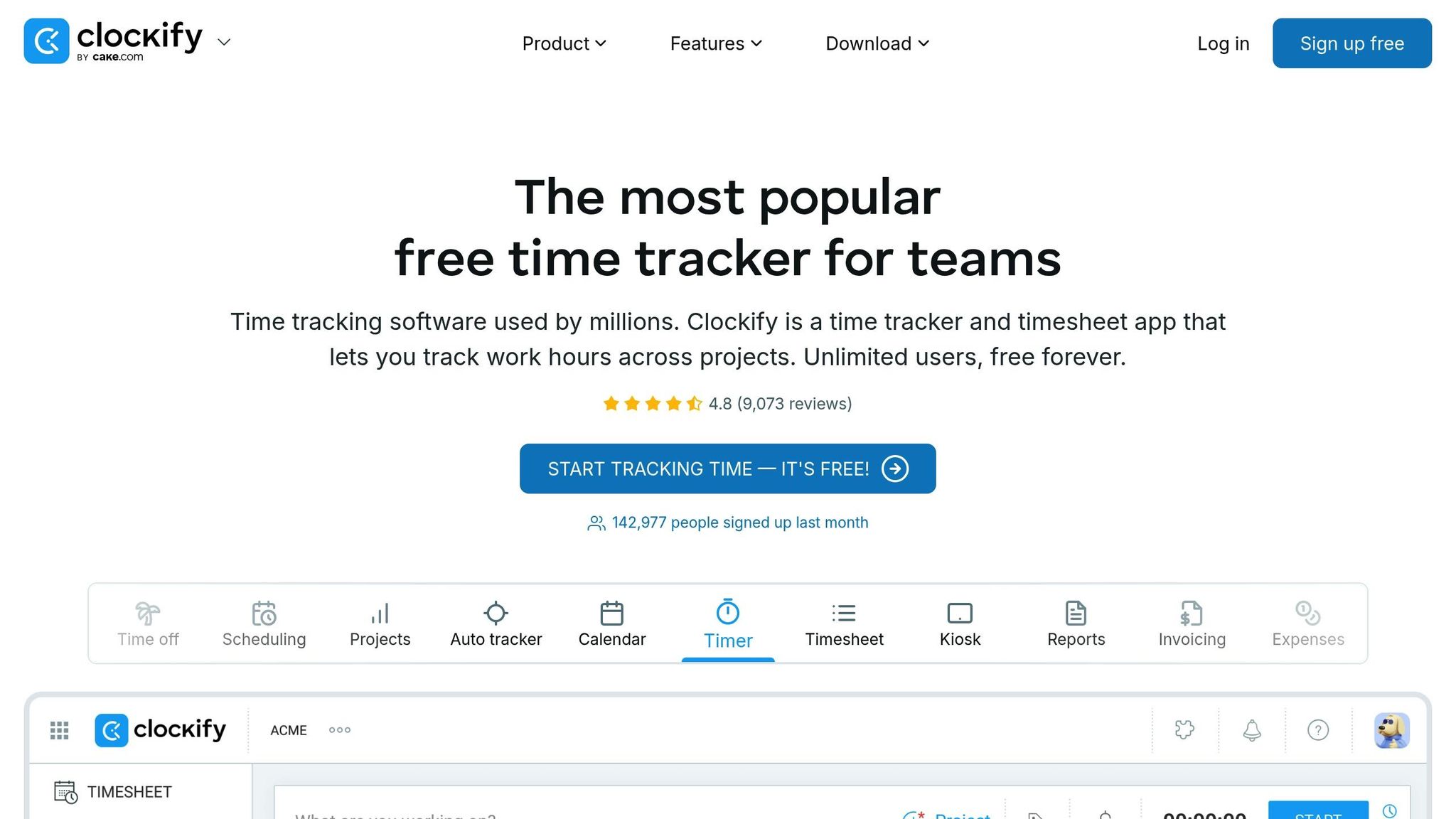
Clockify is a cloud-based tool designed to simplify time tracking and improve managing offshore teams.
| Feature | How It Helps with Offshore Teams |
|---|---|
| Real-Time Tracking | Keeps an accurate record of team activities as they happen |
| Project Budgeting | Helps monitor costs and allocate resources effectively |
| Timesheet Approvals | Speeds up payroll by streamlining the review and approval of submitted hours |
Clockify goes beyond basic time tracking by offering detailed reporting. The dashboard provides key metrics like billable versus non-billable hours, project progress, and performance insights for both teams and individuals. Managers can use customizable reports to make data-driven decisions.
The platform integrates with popular project management tools, making workflows smoother. With mobile apps for iOS and Android, team members can track time and submit reports from anywhere, adding convenience for remote work. To top it off, Clockify ensures data is secure with encryption and regular backups.
sbb-itb-d7e6fca
7. Microsoft Teams
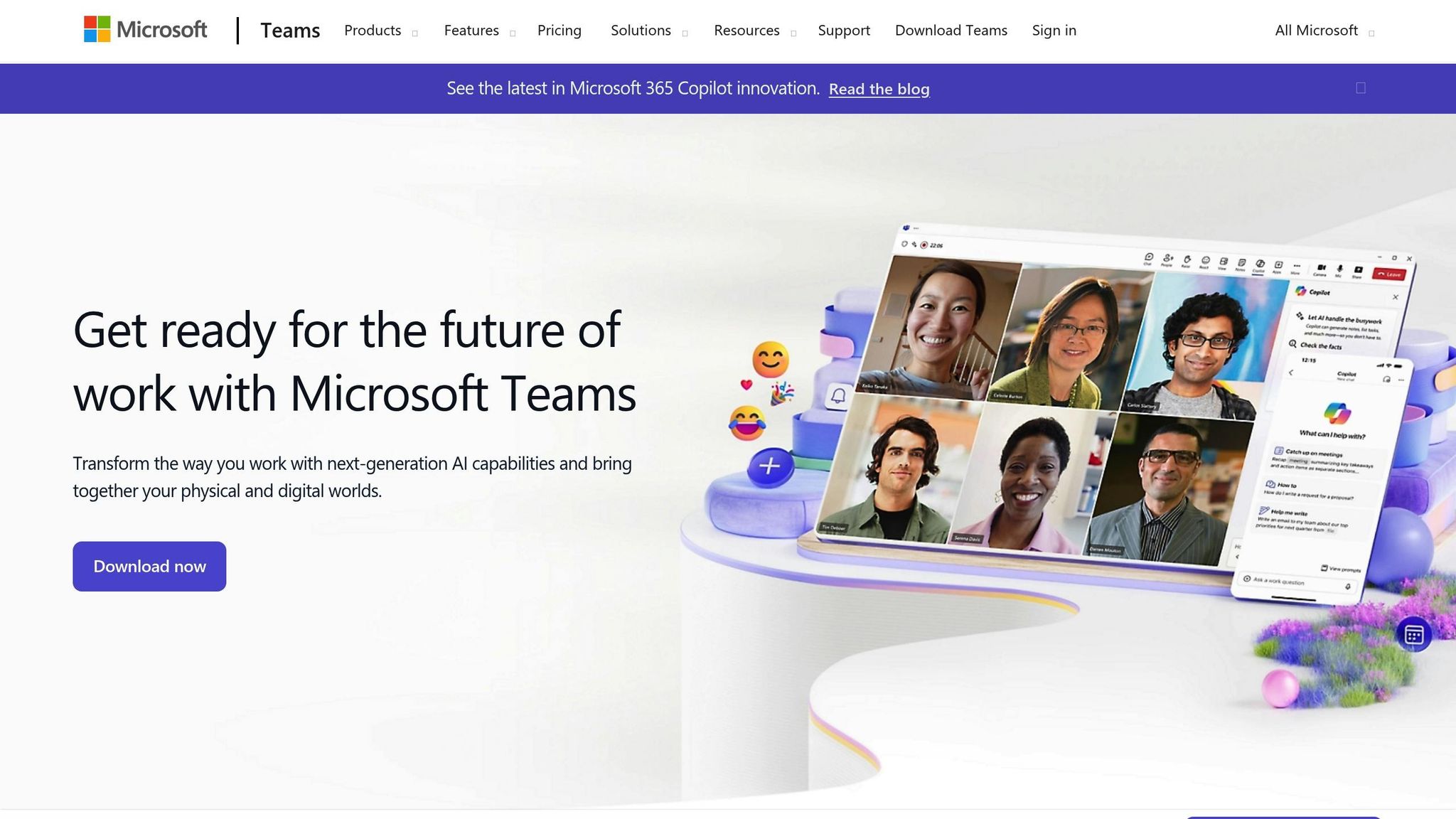
Microsoft Teams includes a range of features designed to help monitor and improve offshore team productivity.
Here’s a quick look at some key features:
| Feature | Monitoring Capability |
|---|---|
| Activity Dashboard | Tracks login times, message frequency, and meeting engagement |
| Attendance Reports | Monitors participation and duration in virtual meetings |
| File Analytics | Reviews document edit histories and collaboration patterns |
| Time Zone Management | Coordinates overlapping work hours using tools like the scheduling assistant and Shifts |
The activity tracking tools in Teams provide real-time data on communication and collaboration. According to a client survey, Teams' collaboration features improved cultural integration by 50%.
Security is another strong aspect of Microsoft Teams. The platform uses enterprise-grade encryption and complies with GDPR and HIPAA standards, ensuring sensitive data stays protected.
Other monitoring tools include:
- Real-time analytics to measure user engagement
- Custom Power BI dashboards for visualizing productivity trends
- Automated status alerts to monitor SLA adherence
- Call analytics to evaluate response times
Additionally, Microsoft Viva Insights integrates with Teams to offer a deeper look into work patterns. This helps managers spot potential burnout risks and streamline workflows. With Teams processing over 5 billion meeting minutes daily, it provides a detailed view of team collaboration and productivity.
These tools make Microsoft Teams a powerful option for managing offshore team performance effectively.
8. Slack
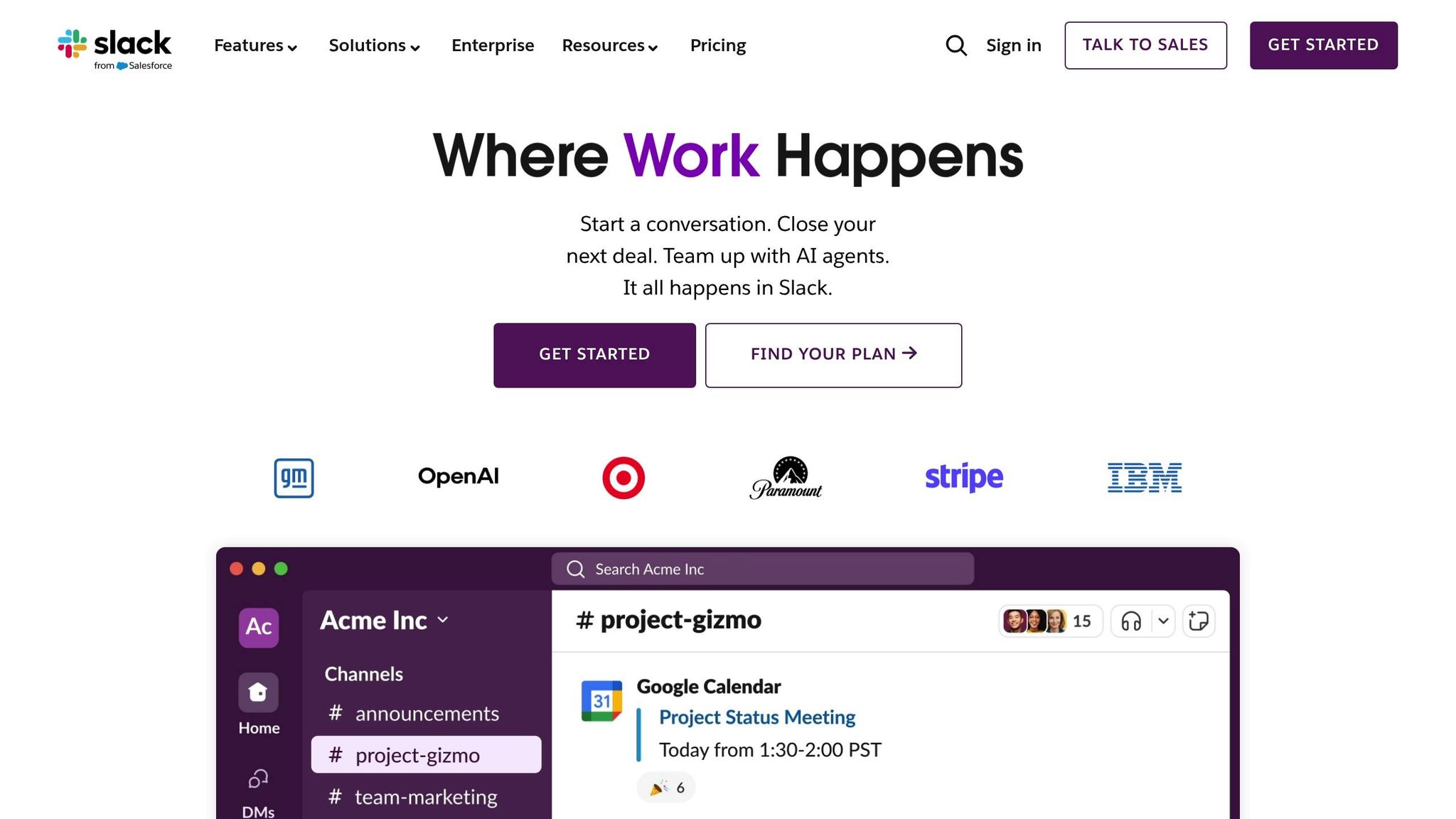
Slack is a team messaging platform designed to simplify communication for offshore teams. With its channel-based structure and extensive app integrations, it helps team members easily access relevant conversations and centralized information. Its user-friendly interface makes collaboration seamless, keeping remote teams connected and on the same page, no matter where they are. Up next, we’ll look at another tool that focuses on improving project management and performance tracking.
9. Jira
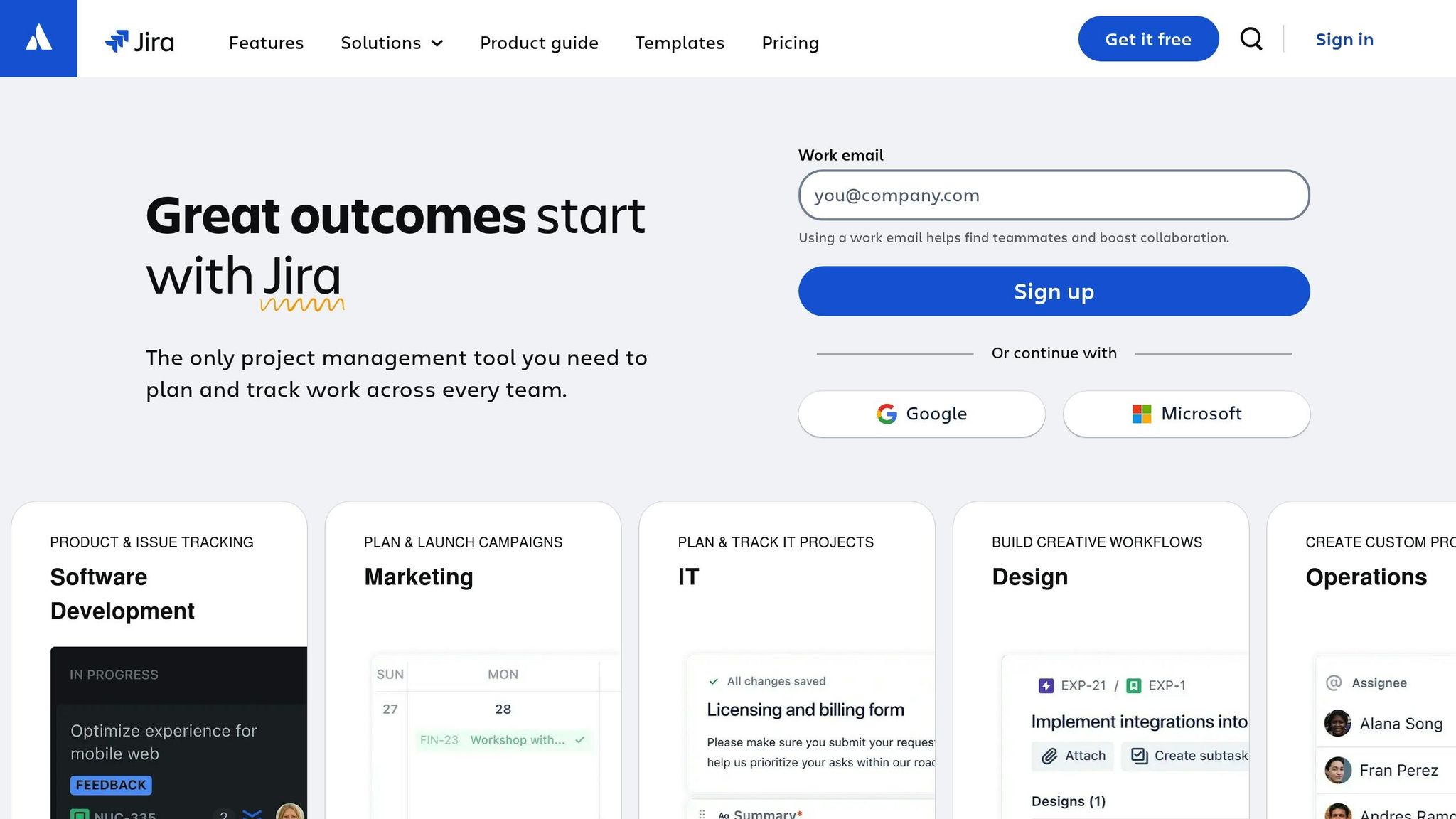
Jira is a project tracking tool designed for distributed teams, offering features to monitor progress, measure productivity, and maintain transparency.
The platform's Scrum and Kanban boards provide real-time updates on tasks, helping teams spot delays and track individual contributions. Team leaders can analyze velocity charts and burndown reports to evaluate performance effectively.
With a customizable workflow engine, teams can adapt workflows to their needs, log task durations, set overdue alerts, and generate productivity reports.
Here are some key reporting tools Jira offers:
- Sprint Reports: Compare completed tasks to initial commitments.
- Velocity Charts: Measure productivity across multiple sprints.
- Cumulative Flow Diagrams: Highlight process inefficiencies.
- Time Tracking Reports: Show hours logged for specific tasks.
| Feature | How It Helps Offshore Teams |
|---|---|
| Time Zone Management | Automatically adjusts schedules for global teams |
| Customizable Workflows | Keeps processes consistent across locations |
| Advanced Reporting | Offers detailed insights into team performance |
| Permission Controls | Protects sensitive data while enabling collaboration |
| Integration Capabilities | Links with other tools for streamlined management |
Jira integrates with various monitoring and communication tools, making it easier to manage offshore teams. Permission controls allow team leaders to set access levels, ensuring sensitive data stays secure while maintaining collaboration.
The mobile app keeps team members connected, letting them update tasks on the go. Additionally, Jira's API supports integration with other tools, creating a unified system for tracking and managing offshore team performance.
Up next: Learn how RescueTime can help track productivity for offshore teams.
10. RescueTime

RescueTime automatically tracks the digital activities of offshore teams, focusing on analyzing work patterns and trends without relying on invasive surveillance.
The tool provides a Productivity Pulse score ranging from 0 to 100, giving managers a quick snapshot of team efficiency. Teams using RescueTime often report productivity gains of 20–40% thanks to its data-driven insights [11].
| Feature | Benefit for Offshore Teams |
|---|---|
| Automatic Time Tracking | Removes the need for manual time entry across time zones |
| Focus Sessions | Blocks distracting websites during important work hours |
| Privacy-First Monitoring | Offers aggregate data without intrusive tracking |
| Custom Categories | Tailors to roles like developers or customer support |
| Calendar Integration | Syncs with Google/Outlook for accurate meeting tracking |
RescueTime places a strong emphasis on privacy and trust, making it ideal for cross-cultural teams. Its aggregated data approach ensures team trust while still delivering actionable insights [10].
One example: A podcast editor increased their Productivity Pulse from the 60s to 82 by using focus sessions and reducing Facebook usage to just five hours per week [11].
The tool prioritizes efficiency and transparency through features like:
- Automatic categorization of activities
- Tracking across multiple devices for a full view of work patterns
- Offline time logging
- GDPR-compliant encryption
Pricing starts at $72 per user annually [10]. However, there are some limitations:
- No built-in geolocation tracking
- Limited scheduling tools
- A learning curve with the initial interface
With over 1.37 billion hours of screen time tracked across more than 2 million users [13], RescueTime is widely trusted by organizations like The Guardian and Harvard Business Review [14].
"RescueTime's data-driven insights have become invaluable for continuous improvement in remote team performance", says productivity expert Scott Hanselman [12]. "The focus isn't on surveillance but on understanding and optimizing work patterns."
To get the most out of RescueTime, customize productivity categories to fit your team’s workflow and schedule regular focus sessions during overlapping work hours. This strategy supports modern offshore team management by prioritizing insights over micromanagement.
Selecting a Monitoring Tool
Picking the right monitoring tool depends on your offshore team's roles. Here's a quick guide to help you match tools with specific team needs:
| Role Type | Key Monitoring Needs | Recommended Features |
|---|---|---|
| Software Developers | Code commits, project milestones | Project tracking, GitHub integration |
| Customer Support | Response times, ticket resolution | Communication monitoring, time tracking |
| Project Managers | Task delegation, milestone tracking | Timeline views, resource allocation |
| Content Writers | Document progress, revision tracking | Document collaboration, activity logs |
| Virtual Assistants | Task completion, time allocation | Screenshot options, activity tracking |
Criteria for Choosing a Tool
An effective monitoring tool enhances productivity and aligns with your team's specific workflows. Keep these factors in mind:
Team Size and Structure
Smaller teams might only need basic time tracking, while larger teams require more advanced features to manage multiple projects and departments.Work Patterns
Account for team working hours and time zones to ensure smooth scheduling and coordination.Budget
Match the tool's cost to your team's salary structure. For example, in the Philippines, project managers earn about $2,700 per month, while virtual assistants average $800. In Latin America, software developers typically earn $2,300 monthly, compared to Filipino social media managers at $1,000 [1].Integration
Make sure the tool works with your current systems. For instance, developers might need GitHub integration, while support teams may require help desk connectivity.Privacy and Compliance
Opt for tools that protect data, comply with labor laws, and maintain transparency. Focus on productivity metrics rather than intrusive monitoring methods.
Implementation Tips
To make monitoring effective and maintain trust, follow these steps:
- Clearly define role-specific metrics and productivity standards.
- Set up transparent reporting systems.
- Schedule regular check-ins to discuss progress.
Conclusion
Using the right monitoring tools can significantly improve productivity and teamwork. When used effectively, these tools support remote collaboration by promoting accountability and transparency.
By tailoring monitoring solutions to fit specific team roles and pay structures, companies can better manage diverse offshore teams. The right tools ensure that team functions and performance needs are met efficiently.
Some key benefits of monitoring tools include:
- Better communication across time zones
- Accurate tracking of time and productivity
- Smarter resource allocation and workload distribution
- Performance reviews based on data
These benefits highlight the importance of picking tools that fit your team’s unique needs. Success in managing offshore teams relies on tools that enhance team performance without undermining trust or morale.
Monitoring tools should focus on improving productivity with clear metrics and open communication.
FAQs
What should I consider when choosing the best monitoring tool for my offshore team?
To choose the right monitoring tool for your offshore team, start by identifying your team's specific needs, such as tracking productivity, monitoring time, or measuring performance. Look for tools that offer features aligned with these requirements and ensure they are user-friendly and scalable for your team size.
Next, compare the costs of different tools and evaluate the value they provide. Prioritize tools that fit within your budget while delivering the functionality and insights necessary to support your team's success. Additionally, consider tools that integrate seamlessly with your existing workflows to avoid unnecessary disruptions.
What privacy and compliance factors should you consider when using monitoring tools for offshore teams?
When using monitoring tools for offshore teams, it's crucial to prioritize privacy and compliance to ensure ethical practices and legal adherence. Start by verifying that the tools comply with relevant data protection laws, such as GDPR or CCPA, depending on your team's location and client base. Always inform employees about the monitoring practices and obtain their consent where required.
Additionally, ensure that the tools you use have robust data security measures, like encryption and limited access controls, to protect sensitive information. Transparent communication and clear policies regarding monitoring can help build trust and maintain a positive work environment while staying compliant with regulations.
How do monitoring tools help improve communication and productivity for offshore teams working across time zones?
Monitoring tools play a crucial role in enhancing communication and productivity for offshore teams, especially when working across different time zones. These tools provide real-time tracking of tasks, deadlines, and performance metrics, ensuring everyone stays aligned regardless of location.
Many tools also include features like time zone synchronization, enabling teams to schedule meetings or updates at mutually convenient times. Additionally, they offer centralized communication hubs, reducing delays and miscommunication while fostering collaboration and accountability. By streamlining workflows and providing transparency, monitoring tools empower offshore teams to work more efficiently and stay connected.